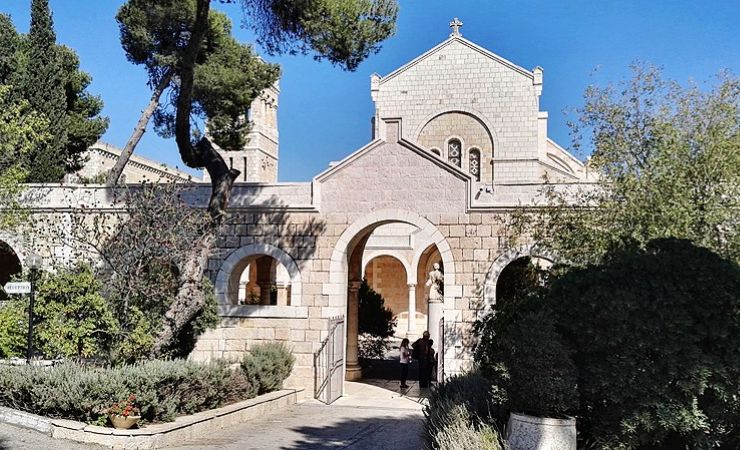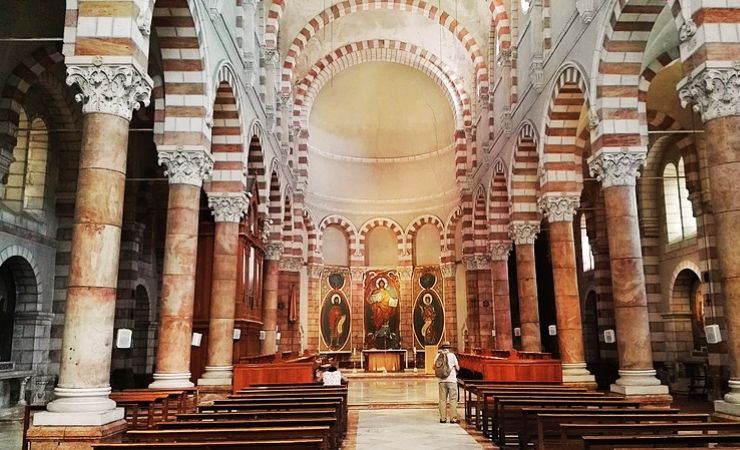Jerusalem’s Saint-Étienne: Where Martyrdom and First Temple Tombs Meet
Near the bustling Damascus Gate, lies Saint-Étienne Church, also known as St. Stephen’s Basilica. This Catholic site, that houses tombs from the First Temple period, offers a serene space for reflection and a deep dive into Jerusalem’s ancient past.

Location
Saint-Étienne Church is situated on Nablus Road (Derekh Shekhem), within the grounds of the École Biblique et Archéologique Française.
History
Saint-Étienne Church’s story begins in 439 AD when Empress Eudocia decided to honor St. Stephen, the first Christian martyr, with a church. His martyrdom, vividly described in Acts 7:54-60, is a cornerstone of Christian history. The original church was constructed to house St. Stephen’s relics, believed to have been found in a cave in the Shephelah region (modern-day Beit Jimal).
During the Byzantine era, the church became an important worship site. However, it was destroyed during the Persian invasion in 614 AD. The Crusaders later restored parts of the church, but it was again demolished during conflicts with Sultan Saladin.
The current Saint-Étienne Church was established by the French Dominicans in the late 19th century. Comte Marie-Joseph de Piellat purchased the site in 1882 and began its restoration. The basilica, consecrated in 1900, is now part of the École Biblique et Archéologique Française, a leading institution for biblical and archaeological studies.




Architectural and Archaeological Highlights
- Byzantine Architecture: The church’s design includes a mono-apsidal basilica structure and a polygonal apse. Its architecture reflects Byzantine influences, characterized by grand, open spaces and detailed mosaics. The church features a striking bell tower and an expansive atrium that welcomes visitors with its serene atmosphere. The interior is adorned with beautiful frescoes, an impressive organ, and intricate carvings, creating a reverent and majestic ambiance.
- Historic Library: The library at the École Biblique et Archéologique Française, housed within the Saint-Étienne complex, is renowned for its extensive collection. The library, often referred to simply as the École Biblique Library, contains over 150,000 volumes and 400 specialized periodicals, covering biblical exegesis, archaeology, and ancient languages. It is a crucial resource for scholars and students from around the world.
The First Temple Period Tombs
One of the most remarkable findings at Saint-Étienne Church is the discovery of tombs from the First Temple period. These rock-cut tombs were unearthed during the restoration in 1885 and offer a fascinating glimpse into ancient burial practices.
These tombs are characterized by their distinctive construction:
- Rock-Cut Chambers: The tombs were carved directly into the rock, a technique commonly used during the First Temple period, showcasing the architectural practices of that era.
- Multi-Chamber Layout: These tombs often feature multiple chambers, suggesting they were used by families or groups. Each chamber had specific functions within the burial complex, including niches for placing the deceased and storage spaces for funerary objects.
- Funerary Objects: Excavations revealed various artifacts within the tombs, including pottery, jewelry, and other items that were typically placed with the deceased. These objects provide insights into the burial customs and beliefs about the afterlife during the First Temple period.
The importance of these tombs lies in their historical context as they date back to a critical period in Jerusalem’s history, offering insights into the city’s development and the lives of its inhabitants during the First Temple period. The well-preserved state of the tombs allows for detailed study of ancient burial practices, enriching our understanding of cultural and religious practices of the time. Moreover, as part of the École Biblique et Archéologique Française, the site serves as an educational resource for scholars and students of archaeology and biblical studies. The tombs provide a tangible connection to the ancient past, enhancing the educational experience at the school.
Sources and Additional Information
Catholic News Agency
The Garden Tomb and the Misfortunes of an Inscription
École Biblique
Nearby Sites
- Damascus Gate: A historic entrance to the Old City, renowned for its vibrant market and rich history.
- Garden Tomb: A peaceful site considered by some to be the burial and resurrection place of Jesus.
- Rockefeller Archaeological Museum: Home to a vast collection of artifacts from the region, offering deep insights into Jerusalem’s history.
- Mamilla Mall: An open-air mall , perfect for shopping and dining with scenic views of Jerusalem. Minutes away from the Jaffa Gate, the Mamilla Pool, and the YMCA Building.



